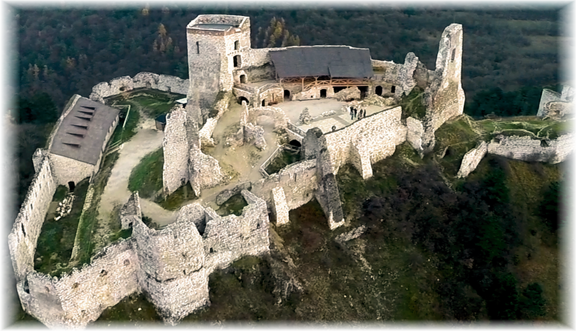

Čachtice castle is located in the western part of Slovakia, in Trenčiansky district, near Višňova village. It was built on a dolomite rock and the first written evidence about the existence of the castle comes from 1276, when it was one of the fortresses protecting the borders with Moravia. In 1299, the castle was conquered by Matus Cak Trenciansky, a very important person of that time. From 1392, the castle and its surroundings belonged to Stibor I. Afterwards, the castle switched its owners often until 1569, when the Nadasdy family acquired it. Ferenc Nadasdy I died in 1604 and his widow, the Hungarian countess Elisabeth Bathory, inherited the castle.
Elisabeth Bathory (1560-1614), also called the Lady of Čachtice, was famous for her cruelty and despotic nature, especially towards girls and young women. The legend says she took baths in virgins´ blood, however, this was never proven. It was proven she tortured and killed her victims not only in the castle, but also in a nearby village and on her travels. Elisabeth Bathory was labeled as the most prolific female murderer by the Guiness Book. The exact number of her victims remains mystery, however, at least 29 of her victims´ bodies were found, while some sources say, she may have killed up to 600 people. Many of her victims were cruelly tortured before their death. Elisabeth´s crimes were found and there was a court trial, after which she was bricked in the castle in rooms without windows, with just small holes for passing the food and ventilation, until her death four years later. She was buried right in the castle or in a nearby chapel.
After Elisabeth Bathory´s death, her descendats inherited the castle. They made significant repairs of the buildings and roofs, but Ferenc Nadasdy III (Elisabeth´s son) was later executed for taking part in a rebellion and after this, the castle was confiscated by the emperor´s troops who robbed it, destroyed large parts and put the castle to fire. Later, there were several minor battles to defend the castle, but it never gained its former importance again and was left to decay.
At the beginning of its existence, the castle had one tower, yards, several rooms for accommodation and shelters for tools and animals. Later on, another tower and a chapel were built. A five-floor tower with a three-floor building became the dominant part of the castle. There was also an entrance gate with two massive bastions. As the castle grew, it was divided into the lower, central and upper parts. The lower and central parts served as defense and maintenance areas while the upper castle comprised offices, representative rooms, accommodation facilities for the nobles, the dining room and treasury room. There was a water tank, too.
In 2012-2014, the ruins were significantly reconstructed, the walls were repaired, the yards and several rooms were cleared and some more works were done. Nowadays, Čachtice municipality is the owner of the castle. You can visit the ruins of the castle and explore it on your own or with the guide. There are frequent cultural events held throughout the year, too.
You can order in our e-shop.
Back




















